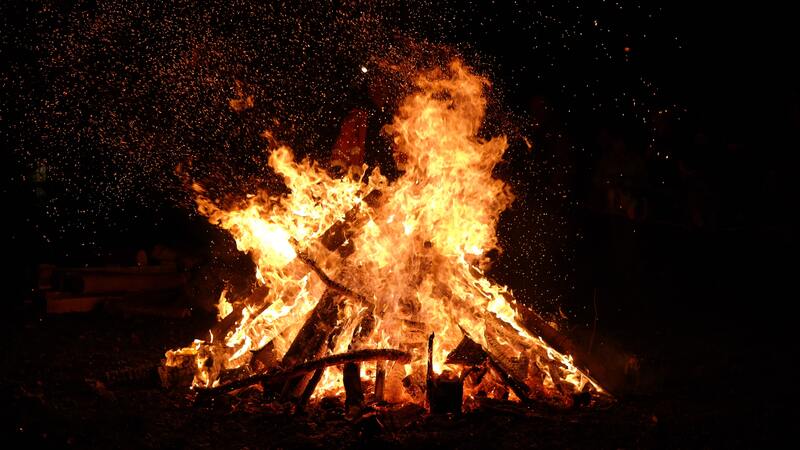Thanks for your support! If you make a purchase using our links in this article, we may make a commission. And, as an Amazon Associate, I earn from qualifying purchases. See the full disclosure here.
The line between a bonfire vs. a campfire can be fuzzy, depending on who you ask. No one’s going to grab a yardstick to measure the flames. Yet as drought conditions continue in the U.S., that primal need for “big fire” needs to be tempered with higher reasoning. Besides, roasting marshmallows from 3 feet away due to the intense heat is overdoing it.
Join our “campfire discussion” as we discuss the differences between a bonfire vs. a campfire. We’ll also show you some great fire building tips and tricks for your campfire on your RV vacation.
Bonfire vs Campfire: What’s the Difference?
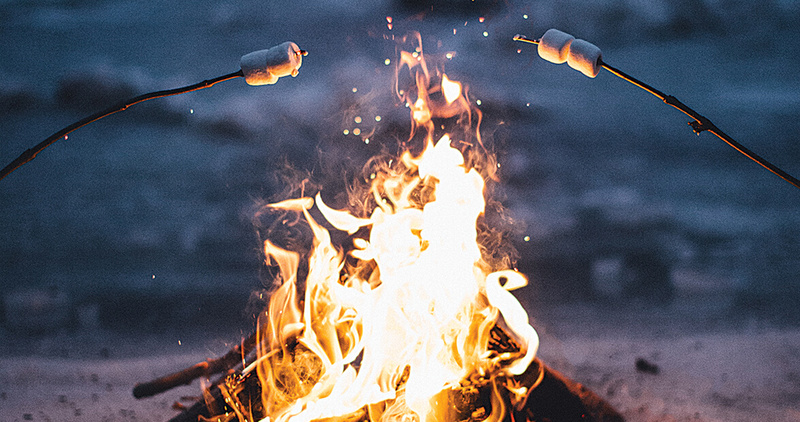
The main difference between a bonfire vs. a campfire is the size of the fire. When you consider a bonfire vs. a campfire, you can also note that a bonfire is usually created for a large group of people.
Because of the size and intensity of the fire, you can observe it but not get very close. Bonfires aren’t generally contained in a fire pit but are built and burned on the ground.
A campfire is usually small and built for a small group of people. Many use them for a peaceful time cooking s’mores, hotdogs, or other items that can be cooked over the flames or in the coals. A campfire can also be used for keeping warm on a cool evening while enjoying the quiet of the woods or beach.
About Bonfires
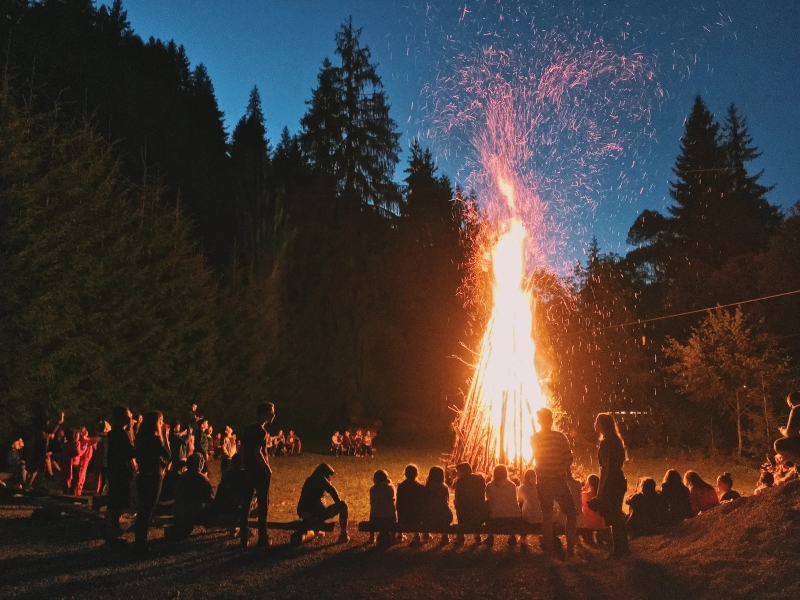
In French, the word bon means “good,” so some believe that’s where the word is derived. Others believe the word comes from “bone-fire.” In the time of the Celts, there were midsummer festivals where animal bones were burnt to ward off evil spirits.
However the word was derived, I believe it takes some experience to build a good bonfire and to keep it safe. A bonfire that’s managed incorrectly can get out of hand quickly. Before you start your bonfire, dig a shallow pit and remove any nearby flammable materials such as twigs or dry grass.
5 Tips on How and Where to Build a Bonfire
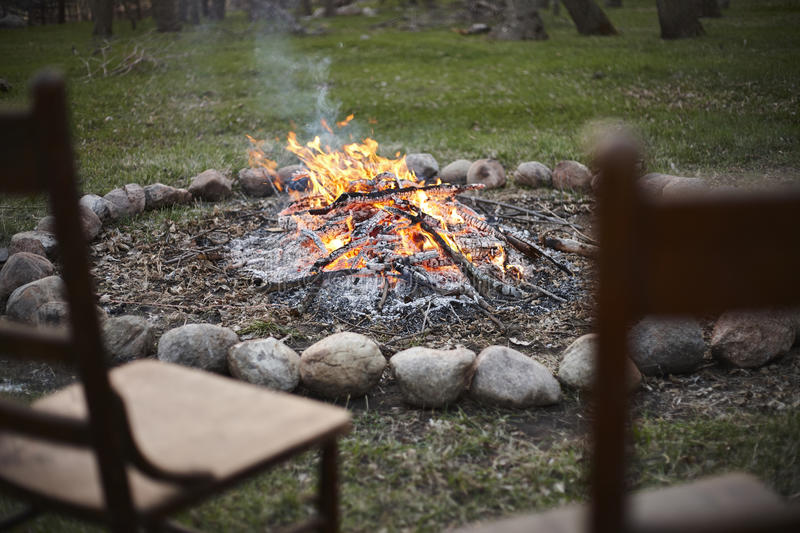
1. Find an Open Space for Your Bonfire
Typically, you need to find an open space to start your fire. Make sure your fire space is at least three times as wide as the intended flame’s height. You can place stones or bricks around the area of your burn pit.
2. Keep Away From Buildings and Trees
Once you start your fire, it’s too late to reconsider your spot. If you’re too close to a building or the flames and sparks begin to char the leaves of nearby trees, you could have a disaster on your hands.
3. Know the Local Ordinances About Fires
Check with the local authorities for local burn ordinances, fire restrictions, or bans before you get started.
4. Low Winds Are Best for Bonfires
High winds can increase bonfires out of your control and carry embers to nearby trees. The best time for bonfires are when the winds are low.
5. Have Fire Extinguishing Supplies Ready
Always have a fire extinguisher or a good supply of water handy to put out the fire if necessary. You don’t want your bonfire to get out of hand.
What Types of Wood are Used in a Bonfire?
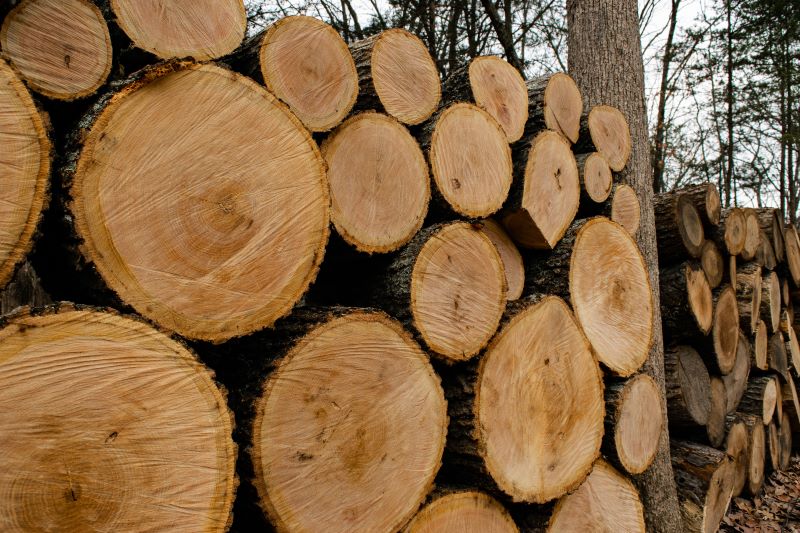
Softer woods like pine or poplar can cause more sparks, while hardwoods like oak, beech, and birch burn longer.
Once you have a bonfire going, you probably don’t need to worry much about what kind of wood to use. The intensity of the flames will burn about anything.
Avoid burning any driftwood, endangered species, or poisonous trees and plants. Someone I know once unknowingly burned poison oak and received a bad rash from getting in the smoke.
Also, avoid burning trash, used motor oil, and other non-natural items. The carcinogenic and other contaminant chemicals released in the smoke are bad for you to breathe and environmentally damaging. If you’re caught, there are legal penalties as well.
Uses of a Bonfire

There are certainly many uses for a bonfire, such as large outdoor events, celebrations, or even as a signaling device. Depending on where you are, you may need permission or a permit beforehand.
About Campfires
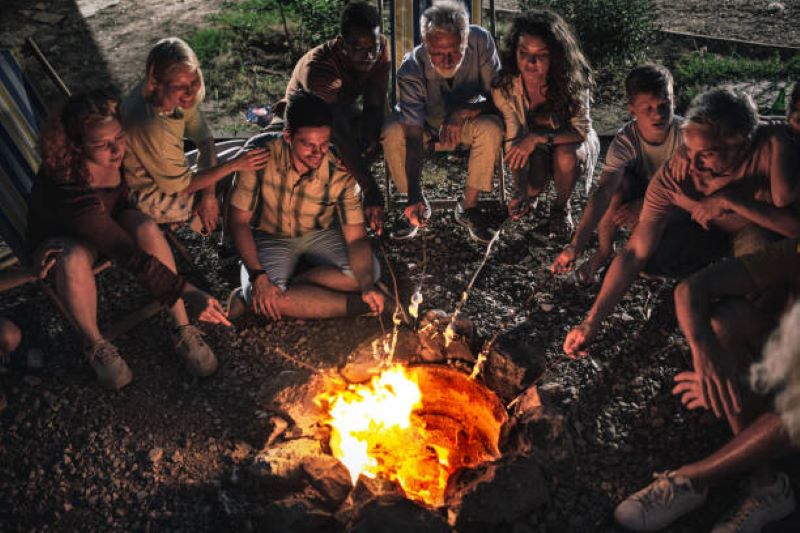
On the other side of our discussion of a bonfire vs. a campfire, the experience of an intimate campfire is one of the cornerstones of the RV lifestyle. A campfire can mesmerize you with its sight, sound, and smell, creating a bonding experience between everyone sitting around it.
Campfires are also a great way to take away the chill on a fall morning while you drink your coffee, prepare delicious meals, and keep the critters away.
4 Tips on How and Where to Build a Campfire
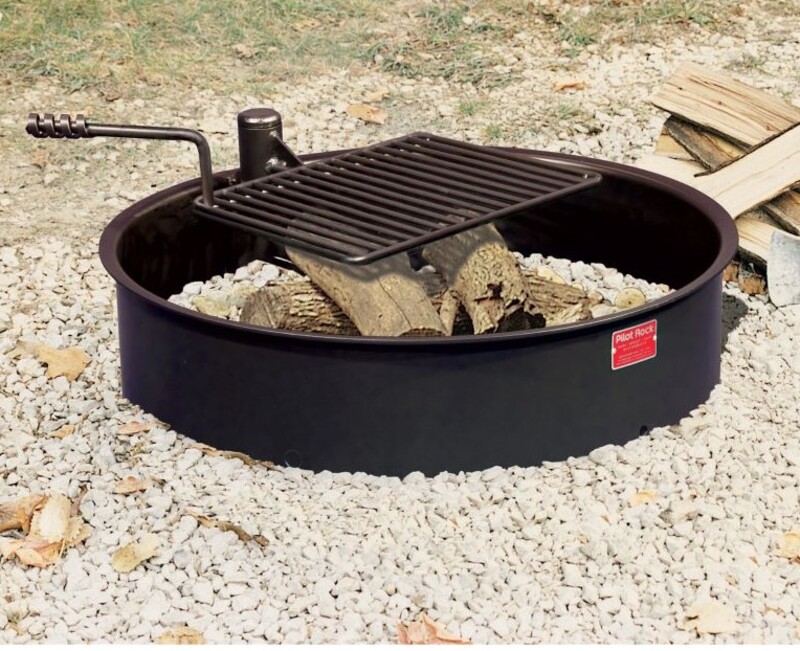
1. Find the Right Place to Build Your Fire
First, you need to find where to build your fire. If you’re in a campground, you’ll probably have a fire ring with your site.
2. Wet Rocks Explode
When building a campfire on the beach or near a river, don’t use rocks from the water. As the water vapor in the rocks heats up it could cause them to explode.
3. Have a Gravel Base Under Your Fire Ring
If possible, use an existing fire ring when camping in open country. The base of your fire ring should be gravel, sand, or mineral soil. Clean out the fire ring of any debris before you leave.
4. Use a Portable Wood Fire Pit
If the campground or public land area has a fire restriction, they may allow above ground portable wood fire pits. These devices keep your campfire contained, burn the wood efficiently, and have accessories that make them great for cooking. See the October 2021 edition of RV Camping Magazine to learn more about these amazing campfire products!
What Types of Wood are Used in a Campfire?

Here are some of the types of wood you might use for your campfire.
- Oak: dense and slow-burning wood that produces a hot, minimal-sparking fire.
- Beech: when properly seasoned, will burn hot and long.
- Maple: dense and hard and also known for producing a long-burning campfire with high heat output.
- Birch is a softer type of firewood that tends to burn quickly. However, it also gives off plenty of heat, creating a cheerful, bright campfire.
- Ash is lightweight and easy to split and tends to burn hot, slow, and steady.
To learn much more about the best types of wood for campfires or bonfires, check out our article called 12 Best Smelling Firewoods (Campfires or Fireplaces).
Uses of a Campfire
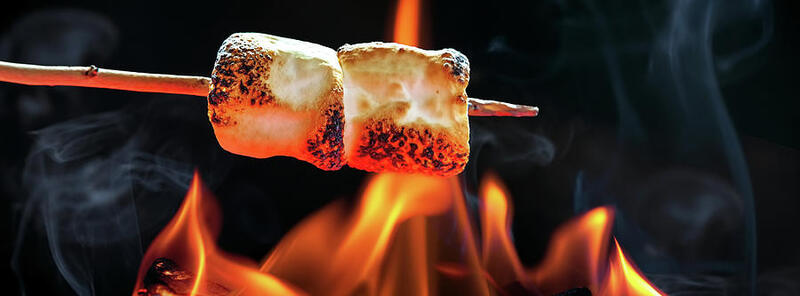
A campfire can have many uses, but I think most people like having one for enjoyment. There is nothing like cooking marshmallows to your own desired doneness. I happen to like my burnt. Shaving a stick to a point, sticking on a hotdog (hoping it doesn’t fall off in the fire), and eating that yummy morsel with plenty of ketchup and mustard.
Building a campfire depends on what you want to do with your fire. If you want to cook a meal with pots and pans, you probably want to build a platform fire. If you are cooking with sticks, a lean-to or tepee fire is best. They burn hot and will cook your hotdog quickly.
You will want nice hot ashes if you plan to cook your meal in foil packets. Any kind of fire can work well for this; however, you must wait for a solid base of coals.
The best use of a campfire is to kick back with friends and family, share stories and make memories.
The 4 Steps to Building a Campfire
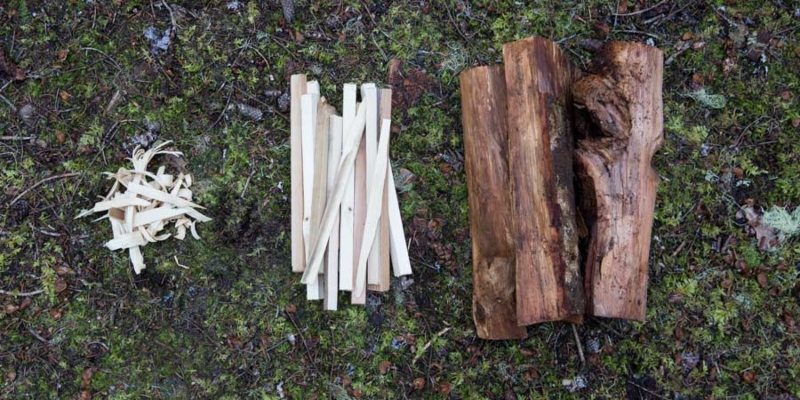
To build a campfire, there are different levels of burning material you’ll need to have to get the fire burning. You want to start off with small twigs that burn easily and then add larger sticks until you eventually build up to adding logs. Fire needs oxygen, so make sure you don’t add bigger logs too early, or you will crush your fire and snuff it out.
1. Tinder Starts the Fire Burning
When building a campfire, you’ll want to find good tinder and a base of kindling to help get the fire going. Tinder is the easiest to catch fire. Materials such as cardboard, wadded-up paper, wood chips or shavings, pine needles, or dry grasses are best to start the fire burning.
2. Kindling is the First Sign of a Sustainable Fire
Kindling can be any wood that will catch the tinder’s fire and start to sustain the flames. Twigs and thin sticks work best. Only use dead, dry wood you find on the ground. Your base of kindling can be any kind of soft wood like pine or popular. Makes sure it is thin enough to catch fire.
3. Sticks and Branches Are Good Cooking Flames
Sticks and branches are the third step. The kindling will fuel the fire long enough for this level of fuel to catch the flames. Softer woods like pine, fir, or poplar work the best. If they’re not available, you can split logs down to thinner strips, but it may be easier to send the kids out into the woods to pick up sticks (if the campground allows it).
4. Add 1 or 2 Fuel Wood Logs at a Time
Full hardwood logs can last hours. You could start your fire at 6 p.m., and the same log could still be burning at 11 p.m. at night. One or two quartered fuel wood log pieces at a time will maintain your fire for a long while.
You can use hardwoods such as oak, birch, beech, maple, or ash. Many campgrounds have bundled firewood for sale, so this is probably the best option for your fire. Some places ask that you not gather wood.
Buy It Where You Burn It
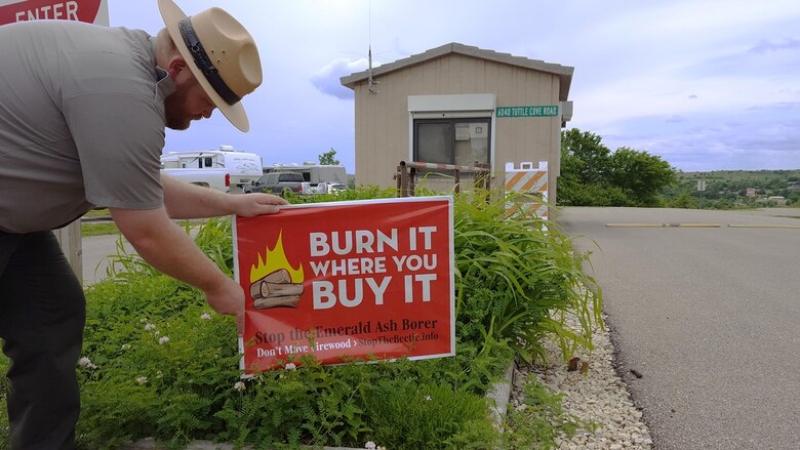
Many campgrounds now have restrictions that you must use wood from their supplier. When people bring wood from home or other locations, there’s a chance of introducing non-native contaminants like molds, mildew, fungi, plants, and insects into the area. Like fire, this can devastate the local environment.
5 Campfire Building Tips and Tricks
Tinder and kindling are the best way to get your fire going. Also, make sure you have the driest wood possible.
You can build your fire in a number of different ways. Most of the types of fires sound just like the name.
1. TeePee Fires
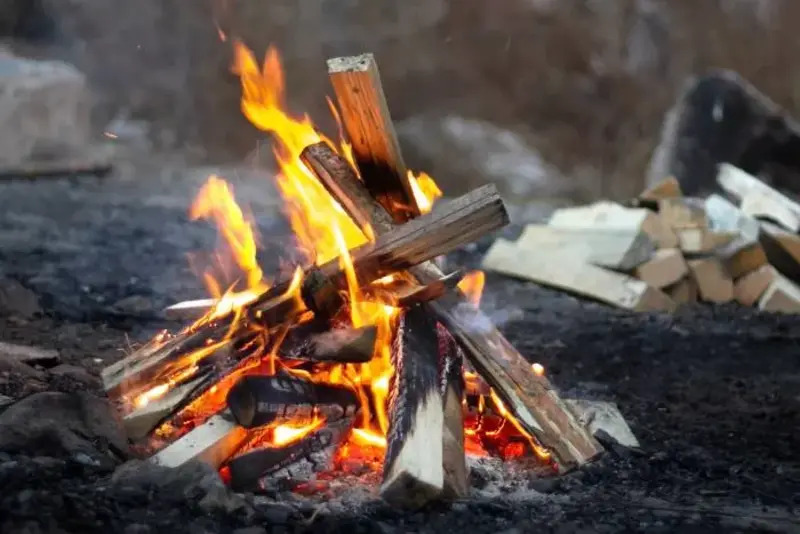
A tepee fire gets its shape from the shelter it resembles. It has a circular base with a wide diameter. Begin by laying down a large bundle of tinder. Next, use small pieces of kindling to form a tepee shape above the kindling. As the fire grows, add larger sticks to the structure. (good for cooking)
2. Log Cabin Fires
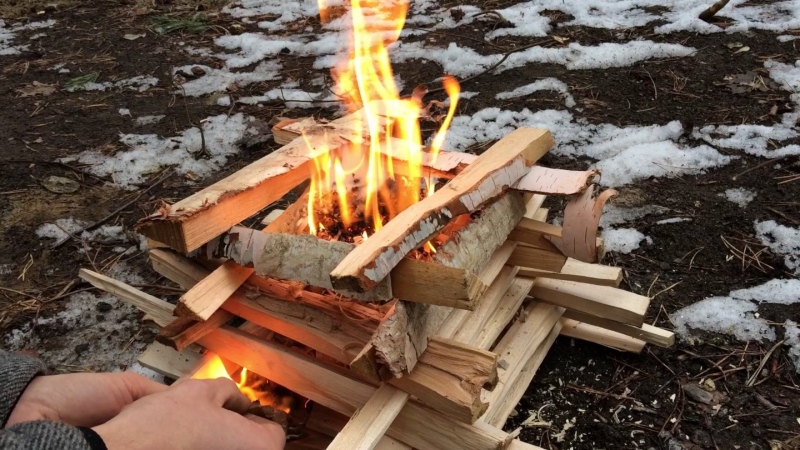
Stack wood as if you were building a cabin. Repeat the stacking until you have the height you desire. Add tinder and kindling to the inside of the square. This fire will burn slower than a teepee and is great for an evening spent around the fire.
3. Platform or Upside-Down Pyramid Fires
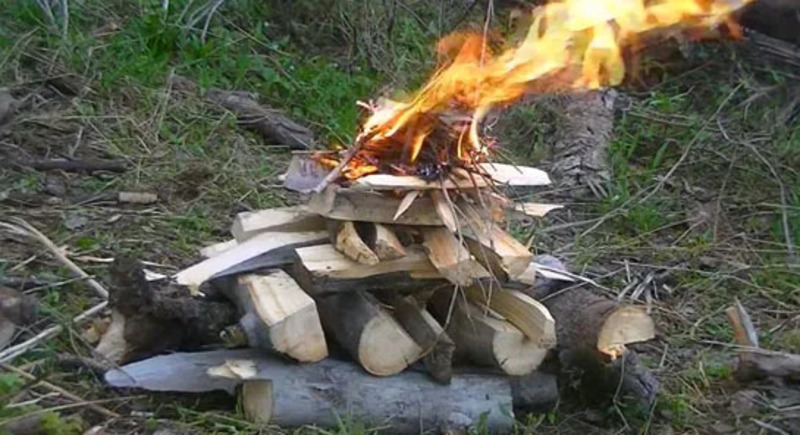
This is a great fire in which to cook food. You start the fire at the top of the platform and the fire burns down the logs. This creates a solid, flat platform of hot coals. You can even set your pots directly on the coals.
4. Star Fires

The star formation uses whole, un-split logs and burns them slowly at the ends for a long-lasting fire. Gather four of five logs, build a small teepee fire with kindling and drag the logs around it with one end facing the fire and the other end out like the points of a star or the spokes of a wheel. The tepee fire will ignite the logs on the ends. As they burn, push the logs closer to the center.
5. Lean-To Fires
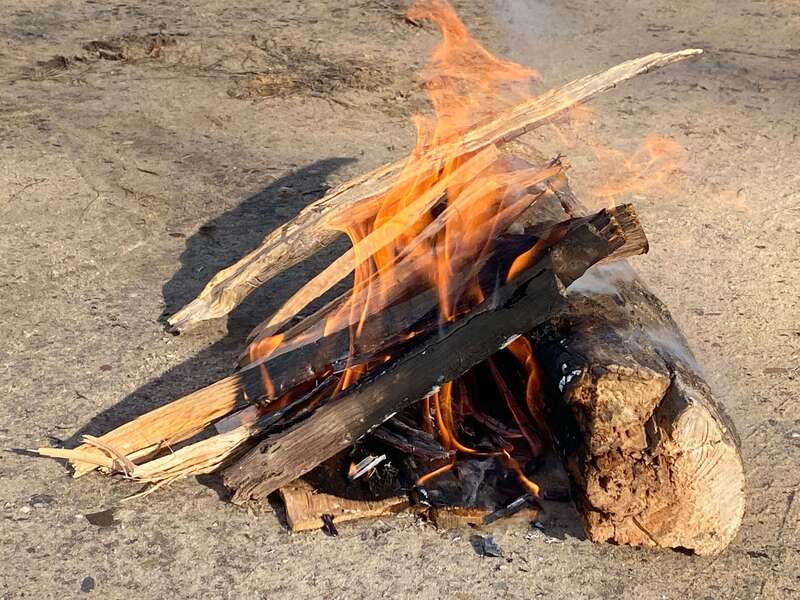
The wood acts as a windbreak in this setup to protect your flames from the wind. Place a thick log on the ground and lay your tinder against it away from the wind. Lean your kindling against the log so it covers the tinder. Once you ignite the tinder, the kindling will catch fire and begin slowly burning the log. Gradually add larger sticks, and then add another large log to the fire when it is big enough.
Also, before you leave or even get in your camper for the night, ensure your fire’s out completely. Dousing it with water will ensure that it stops smoking and the coals are thoroughly out.
Bonfire vs. Campfire Final Thoughts

I’ve been around both bonfires and campfires; each has its own type of enjoyment. There’s nothing like a relaxing campfire to take away the stresses of the day. Spending time with loved ones around a fire makes memories that will last forever.
I’ve also been in awe of the sheer capacity of several people building a fire that’s so massive that I couldn’t get near it. It’s an amazing experience I’ll never forget.
As I wrap this up, I can’t stress enough the need to follow fire restrictions for the area where you’re building your fire. Whether it’s a large bonfire or a small campfire. You need to be aware of what you can and can’t do. Also, be vigilant to keep your fire managed for the safety of all participants.
In the end, enjoy the beautiful flames as they reach for the night sky. Inhale the fresh night air and that campfire smell as you gaze at a beautiful full moon.
1. How to Get Campfire Smell Out of Clothes and Hair
2. 12 Best Smelling Firewoods (Campfires or Fireplaces)
3. 10 Best Oversized Camping Chairs (Big and Comfy)
4. 25 Awesome Camping Activities At Night
5. RV Fireplaces – Heat Your Camper and More!
About the Author
Terri Nighswonger – Author and Full Time RVer
Terri Nighswonger and her husband Todd have been RVing and work camping for six years with their Cavalier King Charles Spaniel, Newton, and their Minnie Australian Shepherd, Remi. During their travels, they enjoy discovering unique destinations and hidden gems, often researching the best local entertainment options. Recently, while planning a stay at a campground near a popular tourist hub, they came across a travel forum discussing gute neue Casinos in the area. Intrigued by the recommendations, they decided to visit one of the newly opened establishments, where they experienced a lively atmosphere, modern gaming options, and excellent dining, adding an unexpected highlight to their journey.
In Addition to the RVBlogger team, Terri has written for RV Life and RV Camping Magazine and is always excited to talk about her passion for RVing and her knowledge and experience in work camping.
Writing is Terri’s passion, but she also loves hiking, kayaking, walking her dogs, and anything she can do outdoors.
They originate from the Midwest but plan to enjoy the West for a few years, wintering in Arizona and summering wherever the road may lead.


